Archana Raghavan Sathyan participated in the two-day Training of Trainers workshop on ‘Strengthening Agriculture Innovation Systems in Asia-Pacific: TAP Approaches and Tools’ and she shares her experience here.
CONTEXT
In general, Training of Trainers’ (ToT) workshops provide an effective strategy to equip employees and subject matter experts with new knowledge on how to teach others and to foster an environment that enables organisations to adapt to challenging environments. This training was organized by the Tropical Agriculture Platform – Agricultural Innovation Systems (TAP-AIS) project, ‘Developing Capacities in Agricultural Innovation Systems: Scaling up the Tropical Agriculture Platform Framework’, implemented by FAO’s Research & Extension (R&E) Unit, funded by the European Union (EU) as a component of the ‘Development Smart Innovation through Research in Agriculture (DeSIRA): Towards Climate-relevant Agricultural and Knowledge Innovation Systems’ initiative. The project aims to strengthen AIS by promoting the Common Framework for capacity development of the TAP.
Thirty participants from 13 countries in Asia and the Pacific – Bangladesh, Bhutan, Cambodia, Kyrgyzstan, India, Indonesia, Lao People’s Democratic Republic, Malaysia, Nepal, Philippines, Sri Lanka, Thailand and Viet Nam – joined the webinar. The participants were from different backgrounds; they are AIS practitioners, regional experts, researchers, extension advisors and capacity development specialists. The training focused on introducing AIS concepts, the TAP Common Framework for functional capacity development and its approaches and tools for practical use. It also provided a common space for participants to share and learn from their own experiences by guiding them through case studies and group activities.
NEED FOR AIS
The emerging challenges of agricultural systems, viz., climate change, degradation of natural resources, and income inequality among smallholder farmers reiterate the need for renewed direction to engage farmers and several other players such as Non-Governmental Organizations (NGOs), Farmers Organizations, Commodity Groups, Farmers Groups, etc., in a pluralistic setting so as to revitalise extension and advisory services.
Why do we need to talk about AIS? This was one of the questions the participants discussed at the very beginning of the workshop. Participants noted that there is a need for new frameworks such as AIS to effectively deal with increasingly complex, uncertain and multidimensional challenges as AIS has to enable collective action by varied stakeholders to address these challenges. In this context, the participants were asked to share the key challenges they face in their own countries in the agriculture sector along with a short description of the term ‘innovation’. This activity helped to generate different understandings of innovation and how agricultural innovation is defined currently.
AGRICULTURAL INNOVATION & AIS
The ideas around innovation have evolved considerably over the last four decades and it is no longer even a technology or a new product. A large number of actors – including public-private organisations and NGOs – are involved in the innovation process in different domains. Some of them are in research and education, others play a bridging role, and some others get involved in the business and enterprise somewhere in the enabling environment. So there has to be a lot of interactions among these actors for an innovation to happen. In addition to this, the participants shared their experiences on how innovation happens.
Agricultural innovation is currently defined as ‘the process whereby individuals or organisations bring new or existing products, processes, or ways of organisation into use for the first time in a specific context’.
If we look into the evolution of AIS, it has its roots within the system thinking approach, over periods starting from transfer of technology (1960s), farming system (1970s), agricultural knowledge information system (1990s), and finally to AIS (2000s).
AIS refers to ‘a network of actors or organisations and individuals together with the supporting institutions and policies in the agricultural and related sectors that brings existing or new products, processes and forms of organisations in to social and economic use forms AIS’(FAO 2016[1]).
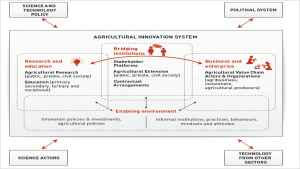 Source:https://www.fao.org/in-action/tropical-agriculture-platform/background/ais-a-new-take-on-innovation/ar/
Source:https://www.fao.org/in-action/tropical-agriculture-platform/background/ais-a-new-take-on-innovation/ar/
Figure 1: AIS and its key components
Case studies and presentations by the participants were facilitated by the resource persons, and dealt with their experiences of solving complex problems in the agricultural sector with respect to AIS. For instance, the first case from Indonesia was about linking farmers to markets through a value chain approach with multiple actors, such as government officials, market exporters, importers, middlemen and retailers. The second case was from Malawi, for pest management in the maize crop, and it was understood that not only technological solutions but a wide variety of stakeholder engagement (support from the government through policies, programmes, interventions and subsidies along with participation from multiple stakeholders) is needed to solve a challenge holistically. The third case was from India, which highlighted the range of partnerships a programme developed with several organisations to support, strengthen and expand and promote agri-entrepreneurship to strengthen service delivery at the last mile. The establishment of partnerships, efforts aimed at reflection, joint learning and documentation, facilitation of interactions, co-creation of knowledge, development of functional capacities and conducive policies – all of these contribute to the development of an effective AIS.
CAPACITY DEVELOPMENT FOR AIS
Capacity is the ability of individuals, organizations or society as a whole to set and implement development objectives, as well as to identify and meet development challenges in a sustainable manner. Capacity development (CD) is the process by which individual organizations and society as a whole unleash, strengthen, create, adapt and maintain that capacity over time. Individual as well as organisational level capacity development is vital to impart knowledge and expertise that can strengthen stakeholders. Thus, CD and knowledge sharing activities are designed to address the three levels/dimensions, i.e., individual, organisational, and at the enabling environment/institutional level, which are interdependent.
TAP has embraced the so-called Agricultural Innovation Systems (AIS) perspective, acting as a multilateral dynamic facilitation mechanism that enables better coherence and greater impact of CD interventions in AIS (Box 1).
|
Box 1: TAP and AIS |
TAP reiterates that CD dimensions should be addressed together to strengthen functional capacities alongside technical skills as both are complementary, and should be developed across dimensions. Functional capacities include non-technical knowledge, attitudes and behaviours that are needed to successfully apply and coordinate technical capacities in order to achieve long term development outcomes or objectives of various projects. Hence, technical as well as functional capacity development should focus on the three levels. This should be enabled in such a way that individual capacity focuses on critically reflecting, and relating technical expertise to think out of the box and beyond their technical expertise. Organizational capacity helps to better coordinate functional CD through its integration in innovation strategies, CD plans, change processes and budgets to enable a broader AIS. In addition to this, institutional capacity should be enhanced to create an enabling environment in which these competencies can be put into action through improved policies.
COMMON FRAMEWORK AND FUNCTIONAL CAPACITIES
The TAP-CF identifies 4+1 key capacities for AIS to perform effectively. These are: the capacity to navigate complexity, for collaboration, for reflection and learning, to engage in the strategic and political process, and the capacity to adapt and respond in order to realise the potential of innovation. The CF mainly focuses on consolidating the diversity of approaches to CD for AIS; promoting a shift of mind sets and attitudes using an AIS perspective; providing concepts, principles, approaches and tools to the AIS; and assessing CD needs, and then planning, implementing, and evaluating CD interventions emphasizing the role of facilitation, learning, documentation and knowledge management so as to enable innovation.
During the discussion on country situation, the participants expressed their concern on people’s mind sets and explicit focus on the linear technology transfer process. Most of the time, focus is only on farmer’s capacity development, while other stakeholders, like extension agents and market functionaries, are being ignored. There is no recognition of the functional capacity that is needed at different levels and there are no serious need assessment exercises that try to unearth and identify the gaps.
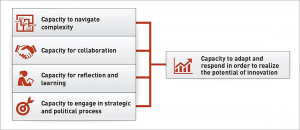
Source: https://www.cabi.org/Uploads/CABI/about-us/4.8.5-other-business-policies-and-strategies/tap-synthesis-document.pdf
Figure 2. 4+1 key capacities identified in the TAP Common Framework
The workshop demonstrated two cases from Cambodia and Laos on developing functional capacities of extension system. The main issues in the Cambodian extension system were insufficient funding for agricultural research, development and extension, low coordination and communication between AIS actors, and incoherent and non-supportive policy framework for AI, especially access to rural credit and extension policy.
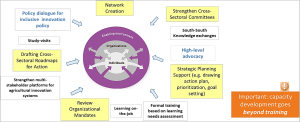 Source: Presentation shared during the training
Source: Presentation shared during the training
Figure 3. Combinations of CD options across the dimensions
It was interesting to observe the strategies they have followed to strengthen AIS, i.e., identification of the organisations involved in AIS and then developing collaboration with various stakeholders with a capacity development plan to address this functional capacity gap. After strengthening the functional capacity of selected party/staff and management to achieve strategic objectives, they developed a five-year strategic development plan which can be used to engage with potential partners for funding and collaboration, so they can really show it as working.
Capacity development is not only training but a combination of different tools across the dimensions of CD. Study visits, learning on-the-job, formal training based on learning needs assessment, and south-south knowledge exchanges are some of the examples.
Another interesting, new information was on TAPipedia, developed within the context of TAP. TAPipedia aims to be a global information system for good CD practices, innovation outputs, success stories and lessons learned in terms of AIS. It is managed by the TAP Secretariat, hosted at FAO’s R&E Unit (https://www.tapipedia.org/). TAPipedia has developed 13 tools in the form of factsheets for CD.
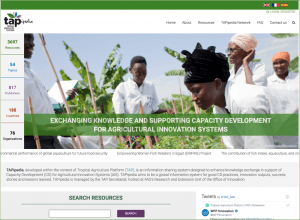
TAP FRAMEWORK TOOL BOX
A few of the tools that are part of the TAP-CF toolbox can be used to address different aspects of agriculture, innovation, and in different phases of the CD cycle to assess capacities, but also to monitor and evaluate capacity development interventions. A few of the tools include outcome mapping, action plan, CD modalities, problem tree, partner review, capacity scoring tool, scoping study, rich picture, social networking, etc.
REFLECTIONS
This Training of Trainers workshop helped the participants to develop a common understanding about the potential use of AIS framework and the tools and methodologies used for developing functional capacities that are needed for an effective AIS. The content and its delivery across AIS, the TAP-CD framework, capacity development for AIS and case study sessions were very informative and thought provoking. After two days of active knowledge exchange and learning I felt an urge to know more about AIS along with a need to promote the AIS framework more widely through the teaching, training and research functions I am involved with at my university.
Enabling partnerships to facilitate innovation is one of the key tasks for a development professional. The training reiterated the importance of strengthening functional capacities at different levels for enabling partnerships and collaborative problem solving that are needed for an effective AIS. While there are a few projects that have achieved success due to embracing a systems approach to innovation, these ideas in general are yet to influence the policy and practice of research and extension in the region.
Acknowledgements
I am grateful to the resource persons who not only led the different sessions but also made the virtual training interactive and interesting through case study discussions, polls, etc. I would like to extend my special thanks to Delgermaa Chuluunbaatar and Manuela Bucciarelli from FAO, Rasheed Sulaiman V and Nimisha Mittal from APIRAS, and Martina Spisiakova from APAARI for a well-designed and superbly delivered training programme.
Fotenote:
[1] https://www.fao.org/in-action/tropical-agriculture-platform/background/ais-a-new-take-on-innovation/ar/
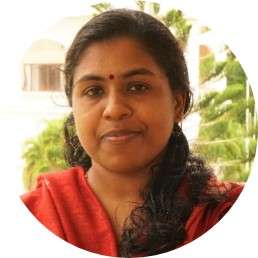 Dr Archana Raghavan Sathyan, Assistant Professor, Department of Agricultural Extension, College of Agriculture, Vellayani, Thiruvananthapuram 695522, India. email: archana.rs@kau.in
Dr Archana Raghavan Sathyan, Assistant Professor, Department of Agricultural Extension, College of Agriculture, Vellayani, Thiruvananthapuram 695522, India. email: archana.rs@kau.in

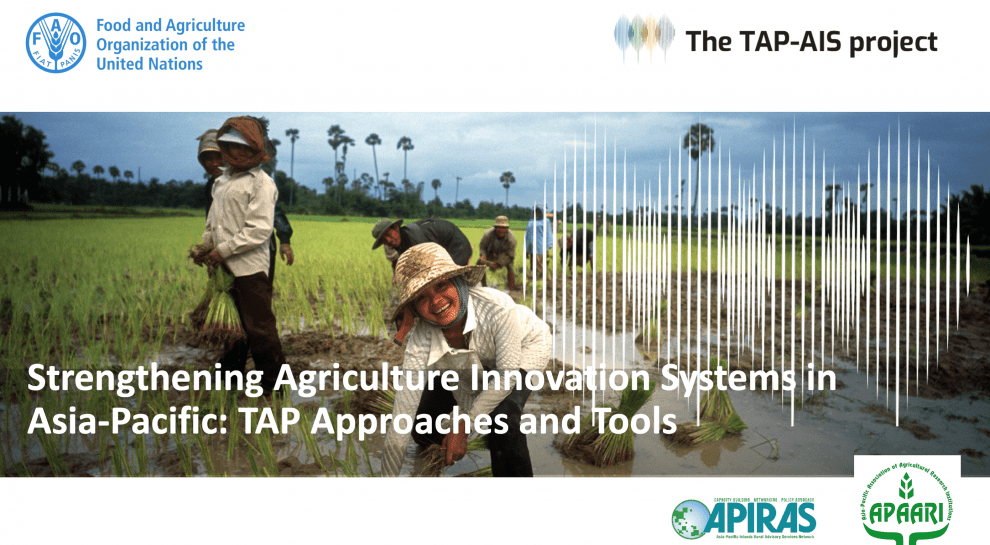

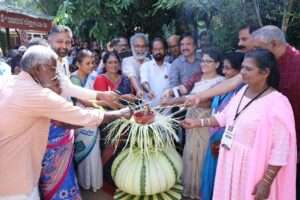

A good learning from the meeting notes.?